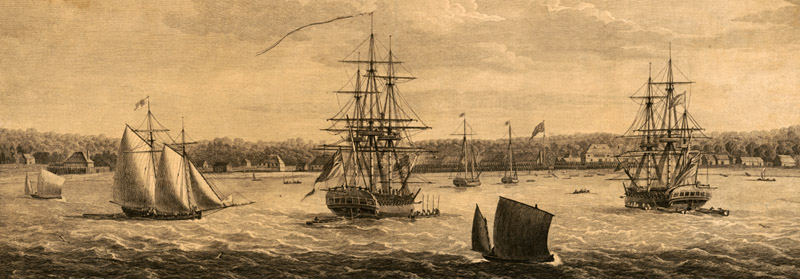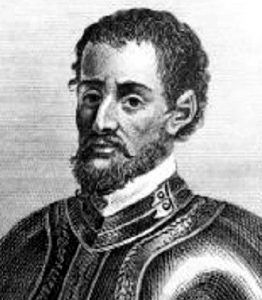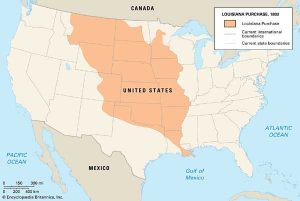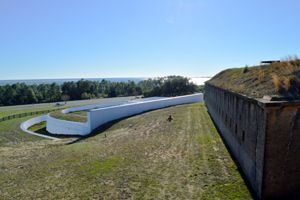The Bateria de San Antonio is a semicircular masonry fortification in Pensacola, Florida, that was designed and built as a shore battery in conjunction with Castillo de San Carlos as part of the late 18th-century Spanish defense system of the entrance channel to Pensacola Bay from the Gulf of Mexico.
Pensacola Bay was discovered by the Spanish adventurer Panfilo de Narvaez, who landed on the south shore of Santa Rosa Island in October 1528. Bon Tristan de Luna y Arellano attempted to establish a permanent settlement in 1559, but it was abandoned just two years later. In 1698, after a 1693 expedition by Don Carlos de Siguenza y Gongora, Spaniards resettled on the shores of Pensacola Bay, and Austrian engineer Jaime Franck built a pine log field redoubt called San Carlos de Austria on the bluff called La Barranca, which overlooked the entrance channel of the bay. After contesting for the bay in 1719, the French destroyed the Spanish fortifications in 1720 and occupied the area until 1722.
When the Spanish returned, a new fortification was built on Santa Rosa Island, which was maintained until a hurricane destroyed the site in 1752. The survivors built a new blockhouse at a slightly higher elevation on Santa Rosa Island, though some established themselves at the blockhouse called Fort San Miguel at the present site of Pensacola. In 1756 the viceroy of New Spain, the Marques de las Amarillas, established the presidio calling it San Miguel de las Amarillas. This induced the king of Spain in 1757 to proclaim by a royal order that the name “Panzacola” would be used. The village, the San Miguel, and the Santa Rosa Island fortifications were turned over to the British in 1763 after the Treaty of Paris. The British built a small stockade with a ditch on Barrancas as part of their fortifications of the bay. All of Pensacola’s s defenses, including Fort George and its redoubts, were surrendered to Spanish forces in the siege of 1781 and were officially turned over to Spain in 1783. After the Treaty of 1783, the New Orleans commandant, Bernardo de Galvez, who governed West Florida, abandoned several British fortifications around Pensacola. However, the Queen’s Redoubt of Fort George, renamed Fort San Bernardo, was officially maintained.
In 1788 though it was proposed to abandon the Pensacola site and relocate the presidio at the bay entrance channel, the officially approved scheme was not instituted. By 1793, when Spain entered another European war, the deteriorated fortifications were proposed to be augmented with the construction of a masonry redoubt and battery on Barrancas. When European warfare abruptly ended, so did the project. It was revived after Spain declared war on England. A council of war in New Orleans authorized early in 1797 the construction of a seven-gun, masonry battery or medialuna on Barrancas. The battery’s rear defense was planned as the Castillo de San Carlos, which held only 150 men, and was built within the earlier British ditch. By 1796, it was necessary to refortify the deteriorating defenses of the bay. The masonry Bateria de San Antonio was constructed in conjunction with the stockade, Castillo de San Carlos, at the rear of the battery. Construction on the bateria and castillo continued during 1797, even though a blockading British squadron captured artillery and supplies shipped from New Orleans.
After Spain ceded Louisiana to France in 1801 and France sold it to the United States in 1803, the stockade on Barrancas was strengthened to defend Pensacola, the provincial capital of Spanish West Florida, from an American invasion, which almost took place in 1813. In 1814, a British command, with the consent of the Pensacola commandant, occupied Fort San Miguel and the Castillo de San Carlos. Following General Andrew Jackson’s invasion of Florida in 1814 to quell Indian insurrections, Fort San Miguel and Pensacola were captured. The British retreated to San Carlos, destroyed it, spiked San Antonio’s guns, and then sailed away, leaving the area to Jackson.
The United States returned Pensacola to Spain. A stockade was rebuilt near the San Carlos site, which, together with the bay, was surrendered again to American forces under Andrew Jackson in 1818 and was returned to Spain early in 1819. The deteriorating defenses of the bay were officially transferred to the United States in 1821 when Spain ceded East and West Florida. U. S. troops were garrisoned on Barrancas until 1825 when the area was turned over to the Department of the Navy.
By this time, it was necessary to fortify the Navy Yard and provide a strong defense point on the Gulf Coast. The U. S. Department of Engineers, which had few men skilled in designing coastal fortifications, finally selected William H. Chase to design and build the forts of Pensacola Bay. In part, Chase’s scheme, a development of the earlier Spanish defense system, adapted Bateria de San Antonio for mid-19th century warfare. It was backed up and connected to Fort Barrancas, which was built on the site of Castillo de San Carlos. Both were surrendered, along with the other mainland forts.
The Territory of Florida officially sold the peninsula between Bayou Grande and Pensacola Bay, which included Barrancas, to the United States for a Naval Reserve in 1832. On the site of Castillo de San Carlos, the U. S. Department of Engineers built, for the Department of the Navy, Fort Barrancas, which was connected to the Bateria de San Antonio, which had largely been rebuilt.
Between 1839 and 1844, the U.S. Department of Engineers, under the supervision of W.H. Chase, altered the Bateria with extensive additions to the earlier Spanish masonry, though the general plan was preserved. The firing platform was rebuilt, and the terreplein was adapted for 13 guns. The original Spanish structure was stuccoed and embellished with ornamental architectural detailing, including aileron enframements of roundel openings over the doors. The Department of the Navy lands were transferred to the War Department in 1844.
Fort Barrancas was held by the Confederates from January 1861 to May 1862, when Union troops recaptured it. The brick fortifications on Barrancas were abandoned after the Civil War. However, the U. S. Army maintained the area, collectively known as Fort Barrancas, until 1947, when it was turned over to the U. S. Naval Air Station. The National Park Service acquired Bateria de San Antonio and Fort Barrancas as part of the National Seashores on July 1, 1972.
The old battery is located near the northeast corner of San Carlos and Hovey Roads intersection at the Pensacola Naval Air Station.
Compiled and edited by Kathy Alexander/Legends of America, updated November 2022.
Also See:
Forts & Presideos Across America
Gulf Islands National Seashore
Source: Library of Congress




